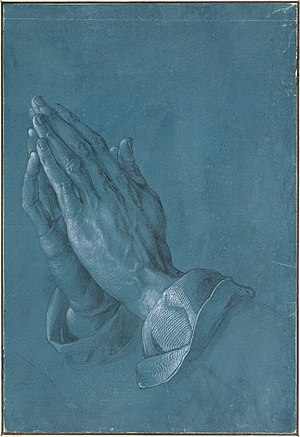Praying Hands (Dürer)
| Praying Hands | |
|---|---|
| German: Betende Hände | |
 | |
| Artist | Albrecht Dürer |
| Year | c. 1508 |
| Type | Drawing |
| Dimensions | 29.1 cm × 19.7 cm (11.5 in × 7.8 in) |
| Location | Albertina, Vienna |
Praying hands (German: Betende Hände), also known as Study of the Hands of an Apostle (Studie zu den Händen eines Apostels), is a pen-and-ink drawing by the German printmaker, painter and theorist Albrecht Dürer. The work is today stored at the Albertina museum in Vienna, Austria. Dürer created the drawing using the technique of white heightening and black ink on (self-made) blue colored paper. The drawing shows a close up of two male hands clasped together praying. Also, the partly rolled up sleeves are seen.
The drawing used to be considered a sketch (study) for hands of an apostle, whose full picture was planned to occupy the central panel of the triptych installed in Frankfurt entitled the Heller Altarpiece – destroyed by a fire in 1729.[1] The sketched hands appear on the triptych on the right side of the central panel, and although the detail appears very similar, it is smaller in size in the triptych. Recently, a more plausible theory of the drawing is that, in its elaborate execution on precious blue paper, it is rather a virtuoso record of the hands in the painting, which Dürer could bring back with him from Italy to Nuremberg.
The drawing also once contained a sketch of the apostle's head, but the sheet with the head has been separated from it. Overall, Dürer made 18 sketches for the altarpiece.[2] The first public recognition of the artwork was in 1871 when it was exhibited in Vienna, and the image is said to depict the hands of Dürer's brother, one of eighteen siblings.[3][4]
The tombstone of Andy Warhol, who had copied the Praying Hands, features a carving based on the image.[5]
References
- ^ www.barefootsworld.net Robert Perry Hardison (Barefoot): "Dürer". Retrieved 2010-05-30.
- ^ (in German) www.welt.de Die Welt "Wie Albrecht Dürer die Betenden Hände erfand", 24 December 2008. Retrieved 2010-05-30.
- ^ (in German) www.focus.de Kultur: "Dürers „Betende Hände“ Tausendmal kopiert", 22 November 2008. Retrieved 2010-05-30.
- ^ (in German) www.theophil-online.de Archived 2012-03-07 at the Wayback Machine Theophil-online, ökumenische Online-Zeitschrift: "Call God - Materialien für einen alternativen Zugang zum Thema Gebet im Religionsunterricht - 2.3.5. Variationen zu Albrecht Dürers Betende Hände", Gerd Buschmann 2002. Retrieved 2010-05-30.
- ^ Dillenberger, Jane D. (February 2001). The Religious Art of Andy Warhol. ISBN 9780826413345.

